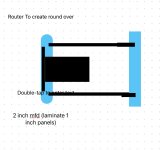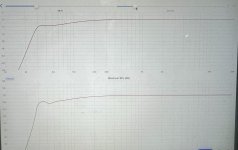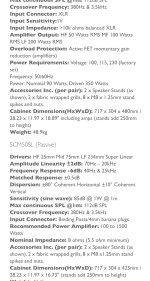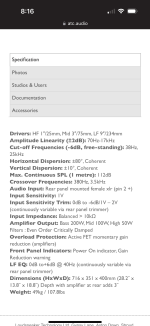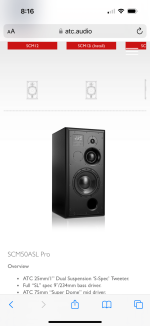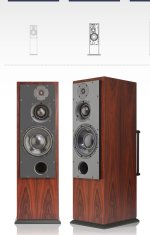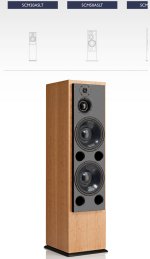I also prioritise realistic dynamics which IMO are far more important than dispersion and diffraction related issues.
Two of the keys to life like dynamics are high sensitivity and high quality pro drivers with low Mms / high Bl and cotton/fabric surrounds.
The Duntech uses what look like "audiophile" (contradiction in terms) heavy coned / rubber surround drivers... Never a good idea.
Lol.
You never listened to a Dunlavy it seems. ( i don't know Duntech so can't comment).
They are along the most revealing loudspeakers i've heard, and because of my work i heard a bunch...
Please point me to a low freq driver with low mms and high sensitivity. Even more from PA world. I won't hold my breath...
Comment about punch: have you some reference to know how the recorded instrument sounded like at first?
The Dunlavy i heard was after recording/mixing i've done for mastering stage so had a point of reference to say they are amongst the most revealing loudspeakers i've heard.
Like Maka said it's preference related about rendering and this cannot be discussed as it is preference.
But burning something without experiencing it is... i don't know how to say?!
I have heard Dunlavy at shows but never been impressed enough to arrange a home demo... Maybe I missed your favourite model... c'est la vie
Why would you want to hold your breath...? Haven't you heard how important deep regular breathing is for health .
.
Some studios have great monitors, others have... Genelec, PMC and KRK... There are plenty of bad sounding studio monitors which are not dynamic and life like in my opinion.
Re references.... At any point any individual can say: "In my experience "The Wonder gut ear-gasim monitors are the best, cause I know my stuff and I think they are the best..."
Blah Blah Blah... Life is to short for "my experience is better than yours" ******* contests... I 'd rather go and practice my breathing technique...



Why would you want to hold your breath...? Haven't you heard how important deep regular breathing is for health
Some studios have great monitors, others have... Genelec, PMC and KRK... There are plenty of bad sounding studio monitors which are not dynamic and life like in my opinion.
Re references.... At any point any individual can say: "In my experience "The Wonder gut ear-gasim monitors are the best, cause I know my stuff and I think they are the best..."
Blah Blah Blah... Life is to short for "my experience is better than yours" ******* contests... I 'd rather go and practice my breathing technique...
As a former national level swimmer ( when teenager) i know how important managed and controlled breath is. 
I didn't say Dunlavy are my favourite speakers but in a good treated room, set up as they should well they are amongst the most revealing i've heard.
You don't get the point about reference: being the one who set up microphone ( and so heard the instrument in the room without anything between them and hears) and mixed for many hours tracks gives a different pov than putting any record on play and say 'this sound good'.
This is where preferences comes into play and as already said this is not something worth questioning.
That said i still wait for any reference of drivers with low mms and hi efficiency for sub... (obviously i know some references like that but there is few and ime sub dedicated one, hence high mms and low efficiency aren't worst as long as you keep them in their intended freq range).
I didn't say Dunlavy are my favourite speakers but in a good treated room, set up as they should well they are amongst the most revealing i've heard.
You don't get the point about reference: being the one who set up microphone ( and so heard the instrument in the room without anything between them and hears) and mixed for many hours tracks gives a different pov than putting any record on play and say 'this sound good'.
This is where preferences comes into play and as already said this is not something worth questioning.
That said i still wait for any reference of drivers with low mms and hi efficiency for sub... (obviously i know some references like that but there is few and ime sub dedicated one, hence high mms and low efficiency aren't worst as long as you keep them in their intended freq range).
Well... National swimmer you say... Once my NASA space walk days were over (breath holding training was tough...  ) I set up with The Three Tenors for a few world tours ... Miss you Luciano!! But I met Hans Zimmer at the funeral and been working with him since... Oh must dash, Matron is coming round with my pills...
) I set up with The Three Tenors for a few world tours ... Miss you Luciano!! But I met Hans Zimmer at the funeral and been working with him since... Oh must dash, Matron is coming round with my pills...






Jealousy?! 
You should not, i was painful training twice a day for many years. That said it had side benefits as girls liked the outcome.
Pmc and Genelec are bad to you? Well each one his own, but here again once correctly setup with good acoustic, both are very workable tools ime ( they translate well).
Of course in random room without treatment... it is equal to youtube video to make a judgement imho.
Krk... well i agree with you! Lol.
We should stop pollute the thread with OT, i would be very pleased to pursue by pm if you want to.
You should not, i was painful training twice a day for many years. That said it had side benefits as girls liked the outcome.
Pmc and Genelec are bad to you? Well each one his own, but here again once correctly setup with good acoustic, both are very workable tools ime ( they translate well).
Of course in random room without treatment... it is equal to youtube video to make a judgement imho.
Krk... well i agree with you! Lol.
We should stop pollute the thread with OT, i would be very pleased to pursue by pm if you want to.
FirstlyThank you for your clear points and explanation here. One that really hit me hard was 'Is it best practice to have the human voice (mid range) spread a 26 inch length?'. I tried hard to think of some ways to mitigate the issue you pointed out, and here are 3 I came up with:
- Use D2004/6020 tweeter whose motor assembly diameter is 55mm. I ditched it earlier due to its dip around 15kHz(I think), but I guess that's something DSP can correct. Will reducing one distance from 80mm to 55mm help appreciably?
- Raise the crossover frequency from 4000Hz to 4500 ~ 5500Hz, so there is less voice component produced by the tweeter. Satori can support that band on axis, but 30-degree response seems to struggle a bit past 5000Hz. How much do you think it can be of help?
- Use the 5" illuminator midbass to reduce another CTC distance. This may call for 4x 7" instead of 2x 8"....
Pls excuse my blathering on and on like a thread hogger.
I think what you are suggesting is correct in principle. But at the risk of upsetting the lateral imaging and soundstage. This is because on axis accounts for only 50-60% of what you hear.
The 5 inch mid bass will work but this may have limited sensitivity and output over a broad 260-4000 range.
The Satori could be placed about the tweeter with the aim of a more coherent point source. I do feel it’s fraught with complexity and hidden problems unfortunately.
I honestly feel you will be rewarded with simplifying the mid - hf section using a highly capable broad range mid or mid bass driver and a good tweeter. Keep it simple. You can always mess with wave guides or AMT later in f you wish.
It’s more over about your overall driver strategy as others here are outlining. Some great posts made.
The compromise is either splitting up the mid range into two bands for more focused driver optimisation or using a single driver for 400- 3000-4000.
You have mentioned the ATC dome. If you can find one great. Problems solved.
Given your prior system l think better means a system that can create more scale and let you further into your music emotionally.
That points to more dynamic driver combinations covering the mud and hf.
The key is using the best wide band mid driver or mid bass driver you can find.
Alternatives to the ATC
l would look at the Acoustic Elegance TD6
It’s a bit like the PHL driver mentioned in one of your replies. 94 db is going to bring out those transient nuances in percussion instruments.
I would mate that with a Bilesma tweeter as they have matching efficiency..
https://aespeakers.com/shop/td/td6m/
A variant on the above is to bring the Beleisma 29mm dome down to 1390 hertz as has +~3mm Xmax.
This gives you very low moving mass in the sensitive 2000 hertz region. You would then be able to scale up the mid cone to 8” inch like the TD8. . Those TD driver are essentially under hung motors.
On mid drivers l would look closely at this 18Sound models.
They are state of art with incredible motor engineering that will absolutely snap with precision and deliver tonal purity.
https://www.eighteensound.it/en/products/lf-driver/10-0/8/10ntlw3500-8ohm.pdf
https://www.eighteensound.it/en/products/lf-driver/8-0/8/8NTLW2000.pdf
Crossover at 1300 hertz to Bileisma 29mm tweeter
The JBL 2123H is another alternative. This is a 3 inch voice coil with a beautiful mid on vocals that won the hearts and minds of numerous studios in the 1980’s.
They are plentiful on EBay. I use them and lm not looking to change it out.
Crossover to the 29mm Biliesma tweeter at 1300 hertz.
https://www.eighteensound.it/en/products/lf-driver/6-5/8/6ntlw2000.pdf
Crossover at 3000 hertz to Bileisma 29mm tweeter with dsp
I am looking at these options as practical for diy and as really excellent transducers that will put your mid and Hf in under 12 inches.
This approach makes your mid high section compact and very capable while simplifying your LF design.
I do appreciate your feeling a bit iffy about building boxes. The above options only require smallish enclosures that could be a sono tube
Take your time on it. Leave it all alone for a bit and then decide. These is a lot of great ideas and suggestions from well meaning people here.
That is one of the two most transcendent commercial speakers. The other is the Snell A/III, another widw baffle speakerThe Sonus Faber Strad you mentioned is a perfect example of a well executed wide baffle.
Thank you for your clear points and explanation here. One that really hit me hard was 'Is it best practice to have the human voice (mid range) spread a 26 inch length?'. I tried hard to think of some ways to mitigate the issue you pointed out, and here are 3 I came up with:
- Use D2004/6020 tweeter whose motor assembly diameter is 55mm. I ditched it earlier due to its dip around 15kHz(I think), but I guess that's something DSP can correct. Will reducing one distance from 80mm to 55mm help appreciably?
- Raise the crossover frequency from 4000Hz to 4500 ~ 5500Hz, so there is less voice component produced by the tweeter. Satori can support that band on axis, but 30-degree response seems to struggle a bit past 5000Hz. How much do you think it can be of help?
- Use the 5" illuminator midbass to reduce another CTC distance. This may call for 4x 7" instead of 2x 8".... daM
Does this sketch make sense? I think the implementation is fairly straightforward.
A sono tube say 10 inch diameter tube and mdf or ply end caps. Router out a grove for the tube in the end caps to slide the tub into and router a curve on the cap. Then router the driver cut out. 35cm deep gives out 17L.
I am sure some diy friends can help you out with the woofer(s) enclosure.
Instead of two drivers covering the mid use a mid with more grunt and pick out a matching tweeter with similar sensitivity
Because the Bileisma 29mm tweeters can cut at 1300 this opens up more possibilities for a mid bass or mid driver. It has 3 mm X max.
All the impact comes from well over the floor delivering a more open tactile presentation.
On the acoustics the wider driver diameter & baffle will let your mid bass/ mid driver go down lower which is what you want.
A sono tube say 10 inch diameter tube and mdf or ply end caps. Router out a grove for the tube in the end caps to slide the tub into and router a curve on the cap. Then router the driver cut out. 35cm deep gives out 17L.
I am sure some diy friends can help you out with the woofer(s) enclosure.
Instead of two drivers covering the mid use a mid with more grunt and pick out a matching tweeter with similar sensitivity
Because the Bileisma 29mm tweeters can cut at 1300 this opens up more possibilities for a mid bass or mid driver. It has 3 mm X max.
All the impact comes from well over the floor delivering a more open tactile presentation.
On the acoustics the wider driver diameter & baffle will let your mid bass/ mid driver go down lower which is what you want.
Attachments
Attatching a mid driver to a tube with rather small diameter is challenging... The driver's frame is flat, you know...
An experienced Cad designer could model a specific piece for cnc or 3d printer, glued to the tube perhaps? But anyway there will be edge discrepancies that cause diffractions in mid's range.
With amateur carpenter skill and tools the task is enormous.
I have done a spherical coaxial using IKEA Bamboo bowls... https://www.diyaudio.com/community/threads/ikea-bowl-speaker-chr-70-gen-3.197798/ The problem with balls is how to kill inside standing waves which are very strong...

An experienced Cad designer could model a specific piece for cnc or 3d printer, glued to the tube perhaps? But anyway there will be edge discrepancies that cause diffractions in mid's range.
With amateur carpenter skill and tools the task is enormous.
I have done a spherical coaxial using IKEA Bamboo bowls... https://www.diyaudio.com/community/threads/ikea-bowl-speaker-chr-70-gen-3.197798/ The problem with balls is how to kill inside standing waves which are very strong...
Last edited:
I believe l have previously fabricated this approach to a midrange enclosure using a cardboard tube. My suggestion is to try out the technique and see how it goes.
The actual baffle can be any shape.
Other enclosure shapes including wedge would work equally well.
A sufficiently wide round over 2-3 inches) is quite satisfactory.
A Jasper circle jig and router can successfully be used to fabricate the front and rear panels.
The actual baffle can be any shape.
Other enclosure shapes including wedge would work equally well.
A sufficiently wide round over 2-3 inches) is quite satisfactory.
A Jasper circle jig and router can successfully be used to fabricate the front and rear panels.
Attachments
Depends on wavelengthA sufficiently wide round over 2-3 inches) is quite satisfactory.
If that is a tweeter on the image, with typical 4" flange around the dome, then any roundover would make better performance than sharp edge there, yeah then the lip like that might better the sound a bit.
My suggestion on the drivers above will require some further research. Given the approach taken my B&W and Wilson Audio l believe the acoustic solution to be solid.
I also believe the suggestions made will increase the probability of successful performance outcome to reduced complexity and unknown acoustics of more complicated solutions such as adding a fill in driver from 800-4000 hertz.
Simple is as a rule a better way with anything in diy audio.
The bass section can be configured as a SBB or BB4 which had the port tuned to the free air resonance of the driver. The identical driver can be placed in a separate sealed critically damped enclosure.
I have owned a system using Scan speak woofers successfully used with the above approach in a highly revered commercial design. A f3 of 30 hertz would not be difficult to obtain in the above configuration without undue bass augmentation near room boundaries.
The enclosure would be either bottom or rear ported due to the low tuning frequency.
The use of dsp crossover will allow tuning the cross overs and the low frequency EQ to work specifically in the users room situation.
Below l have a vented and a sealed simulated the Volt 2500.1 which l understand the user has on hand.
My suggestion is to start with this driver despite being a 10 inch driver and see how it works if proceeding with the single wide band midrange driver.
The Volt 2500.1 has professional specifications and performance to match.
Enclosure volt
Vented 40L shelf tuning (BB4)
F6 28 hertz F3 62 hetz
Closed critically damped
20L
F6 61 hertz F3 94
# The in room response will load the response of these simulation by + 3 db below 100 hertz. It should therefore provide a smooth extension to 28 hertz with a fast upper bass.
I also believe the suggestions made will increase the probability of successful performance outcome to reduced complexity and unknown acoustics of more complicated solutions such as adding a fill in driver from 800-4000 hertz.
Simple is as a rule a better way with anything in diy audio.
The bass section can be configured as a SBB or BB4 which had the port tuned to the free air resonance of the driver. The identical driver can be placed in a separate sealed critically damped enclosure.
I have owned a system using Scan speak woofers successfully used with the above approach in a highly revered commercial design. A f3 of 30 hertz would not be difficult to obtain in the above configuration without undue bass augmentation near room boundaries.
The enclosure would be either bottom or rear ported due to the low tuning frequency.
The use of dsp crossover will allow tuning the cross overs and the low frequency EQ to work specifically in the users room situation.
Below l have a vented and a sealed simulated the Volt 2500.1 which l understand the user has on hand.
My suggestion is to start with this driver despite being a 10 inch driver and see how it works if proceeding with the single wide band midrange driver.
The Volt 2500.1 has professional specifications and performance to match.
Enclosure volt
Vented 40L shelf tuning (BB4)
F6 28 hertz F3 62 hetz
Closed critically damped
20L
F6 61 hertz F3 94
# The in room response will load the response of these simulation by + 3 db below 100 hertz. It should therefore provide a smooth extension to 28 hertz with a fast upper bass.
Attachments
Depends on wavelengthThe baffle lip on the image looks unnecessary in case of a mid / woofer, it would have about as good diffraction performance without it and just with sharp edge that is very close to the driver frame. Only if the tube has much larger diameter than the driver, then you'd add roundover to remove corner between the driver and the tube.
If that is a tweeter on the image, with typical 4" flange around the dome, then any roundover would make better performance than sharp edge there, yeah then the lip like that might better the sound a bit.
The practical issue is obtaining the enclosure volume if a cone midrange driver is used with a narrow tube.
Be aware a circular baffle on the ATC dome mid may introduce a baffle step requiring EQ.
This needs to be assessed during the testing of the mock up.
Referring to ATC hifi and monitors they have a 300 mm front baffle.
A narrow 8 inch enclosure may not be stable and could be top heavy with that ATC driver.
Out rigger plinth could be used for stability
Edit attached the hifi tower systems using 9 inch and 12 inch woofer.
The dual 12 inch system would be my pick..Lol.
Attachments
Last edited:
Hi, yeah this stuff can be approximated for example in VituixCAD with simple ideal baffles and transducers. Although the data doesn't match reality exactly, it would be quite accurate in regards of baffle step for example, and how c-c would affect things, and so on, and what is needed from crossover in sense that if crossover is impossible here then it certainly is in reality as well. If any drivers are not required to go much beyond their diameter wavelength, then I'd say there is not much problems as diffraction and other issues would be mostly out of band, and directivity quite predictable in sense that the simplified simulations get close to reality. You could inspect impulse/frequency response from almost any angle, certainly from horizontal or vertical plane, see the whole spinorama etc. optimize toward what ever ideal is in your mind because it's all virtual and can be done in real time, quite fast to whip up.
VituixCAD makes things quite trivial from technical point of view, only thing left is to connect visual graphs to perception, which is not easy but requires actually building and listening at some point to be able to make connection between graphs and sound. The other thing is, if the sound is not good what the graphs should look like to get better sound, and how to get that kind of graphs
VituixCAD makes things quite trivial from technical point of view, only thing left is to connect visual graphs to perception, which is not easy but requires actually building and listening at some point to be able to make connection between graphs and sound. The other thing is, if the sound is not good what the graphs should look like to get better sound, and how to get that kind of graphs
Here is quick one, few things observable. It's ideal 3" transducer disk on either 12cm endcap of a pipe with sharp edge, or in rough approximation of ATC SCM100 baffle and mid position, also with sharp edge. Bandwidth of the images is limited to 380Hz - 3500Hz which I found was the bandwidth for mid in ATC.


Differences between the two, edge diffraction related backwave makes the big baffle response quite erratic, varies several dB basically on the whole bandwidth. On the other hand DI is relatively stable, because the baffle is big enough for the bandwidth. But to get rid of the diffraction ripple quite big roundovers would be needed to be effective down to about 1kHz. Whether the diffraction is audible is beyond me, perhaps it doesn't matter with usual use case of the speaker.
The small baffle, yeah the bafflestep is there within the passband but it's always somewhere. Directivity goes from low to high within the pass band which means the system response with this mid would be different than the one with bigger baffle, and the whole system would likely be quite different. Perhaps 3" dome is suitable for big rectangular baffle, but not very suitable with small baffle in system context.
These are two very different functional parts for two different systems, although the latter with small baffle is better from purely technical point of view with very smooth response without any undulation, no roundovers required. Both have reasonably smooth DI so could be EQ:d relatively nicely in practice, although first one response varies more per angle within listening window due to edge diffraction secondary sound source. Still, this is not full system, depends on what kind of a full system is needed and which one suits better, perhaps neither! Only the full system matters.
edit. here is polar maps without normalization to show effect of edge diffraction to listnening window:


edit. oops, the atc baffle had only positive angles data at first, now also negative included. Because the driver is offset, diffraction related secondary sound makes interference to vary to any angle. This last image has horizontal response to positive and negative angles to show they differ some. Above line graphs show horizontal and vertical response, not to confuse.



Differences between the two, edge diffraction related backwave makes the big baffle response quite erratic, varies several dB basically on the whole bandwidth. On the other hand DI is relatively stable, because the baffle is big enough for the bandwidth. But to get rid of the diffraction ripple quite big roundovers would be needed to be effective down to about 1kHz. Whether the diffraction is audible is beyond me, perhaps it doesn't matter with usual use case of the speaker.
The small baffle, yeah the bafflestep is there within the passband but it's always somewhere. Directivity goes from low to high within the pass band which means the system response with this mid would be different than the one with bigger baffle, and the whole system would likely be quite different. Perhaps 3" dome is suitable for big rectangular baffle, but not very suitable with small baffle in system context.
These are two very different functional parts for two different systems, although the latter with small baffle is better from purely technical point of view with very smooth response without any undulation, no roundovers required. Both have reasonably smooth DI so could be EQ:d relatively nicely in practice, although first one response varies more per angle within listening window due to edge diffraction secondary sound source. Still, this is not full system, depends on what kind of a full system is needed and which one suits better, perhaps neither! Only the full system matters.
edit. here is polar maps without normalization to show effect of edge diffraction to listnening window:


edit. oops, the atc baffle had only positive angles data at first, now also negative included. Because the driver is offset, diffraction related secondary sound makes interference to vary to any angle. This last image has horizontal response to positive and negative angles to show they differ some. Above line graphs show horizontal and vertical response, not to confuse.

Last edited:
I agree. The user had a bit of ground work to do. Assuming these look more like text book drivers then certain assumptions can be made by an experienced diy audio amateur.
I personally use LinearX Leap 5. As a matter of process l use real data to prepare simulations.
What the user could do is import the Dayton data measurements to test some concepts.
I think the hierarchy of decisions (acoustic design) is important to follow. In diy it’s not unusual to start off purely looking at drivers.
I have tried to cultivate how the user’s proposal may end up being interpreted by looking at known consumer systems that are soa. In these consumer systems belies well founded acoustic design choices. These choices are a good way of testing a diy user’s proposals.
As we discussed we as diy builders may not full appreciate why consumers designs follow certain trends, driver choice until we start to look at them more closely.
In the end it’s about what aspects of subjective rendering are important to the user. Once this is firmly understood then informed decisions and trade offs can be accepted.
I do believe that a simple but well executed mid - hf solution using a high performance wide band single mid driver has a number of benefits to this user.
This frees up a dedicated focus on the low and mid bass solution up to 350-400 hertz using for example a vented and a sealed enclosure. With dsp this is easily optimised by the user.
Of course it’s entirely possible the user may adopt other ideas and that is fine as this is diy.
I personally use LinearX Leap 5. As a matter of process l use real data to prepare simulations.
What the user could do is import the Dayton data measurements to test some concepts.
I think the hierarchy of decisions (acoustic design) is important to follow. In diy it’s not unusual to start off purely looking at drivers.
I have tried to cultivate how the user’s proposal may end up being interpreted by looking at known consumer systems that are soa. In these consumer systems belies well founded acoustic design choices. These choices are a good way of testing a diy user’s proposals.
As we discussed we as diy builders may not full appreciate why consumers designs follow certain trends, driver choice until we start to look at them more closely.
In the end it’s about what aspects of subjective rendering are important to the user. Once this is firmly understood then informed decisions and trade offs can be accepted.
I do believe that a simple but well executed mid - hf solution using a high performance wide band single mid driver has a number of benefits to this user.
This frees up a dedicated focus on the low and mid bass solution up to 350-400 hertz using for example a vented and a sealed enclosure. With dsp this is easily optimised by the user.
Of course it’s entirely possible the user may adopt other ideas and that is fine as this is diy.
- Home
- Loudspeakers
- Multi-Way
- 4-way instead of 3-way?

